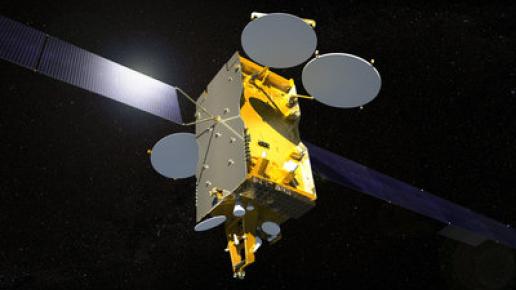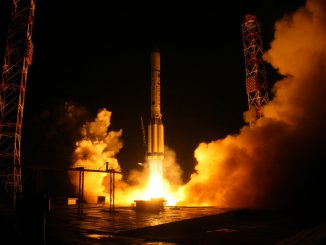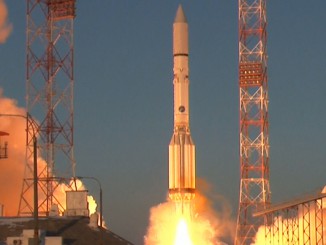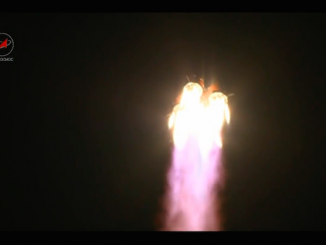
A Proton rocket and Breeze M upper stage deployed a Russian communications satellite in orbit Thursday after liftoff from the Baikonur Cosmodrome in Kazakhstan.
The satellite’s separation from the Proton/Breeze M launcher punctuated a successful nine-hour sequence of rocket burns and started a planned 15-year mission to beam television programming, broadband connectivity, and other services to users across Europe, Russia, Africa and India.
The 191-foot-tall rocket took off from Central Asia spaceport at 2205 GMT (6:05 p.m. EDT) Wednesday, or 4:05 a.m. local time Thursday, carrying the Express AM7 telecom spacecraft.
Firing six RD-276 first stage main engines, the Proton soared into a clear predawn sky, passed the speed of sound, and flew downrange over the sparsely populated steppes of Kazakhstan.
The rocket’s first and second stages jettisoned a few minutes after liftoff, then the launcher’s third stage fired more than four minutes to complete the Proton’s role in the launch.
The mission required five burns by the Breeze M upper stage built by Khrunichev State Research and Production Space Center, the same contractor that manufactures the Proton rocket.
The maneuvers raised the satellite’s altitude and reduced its orbital inclination — moving it closer to a final parking slot in geostationary orbit over the equator.
The Breeze M stage deployed the 5,720-kilogram (12,610-pound) Express AM7 spacecraft at 0718 GMT (3:18 a.m. EDT) Thursday, according to a statement released by Roscosmos, the Russian Federal Space Agency.
The rocket aimed to put the satellite in a temporary transfer orbit with an apogee, or high point, of 35,786 kilometers (22,236 miles), a perigee, or low point, of 5,410 kilometers (3,361 miles), and an inclination of 20 degrees to the equator.
Officials declared the mission a success in post-launch statements, wrapping up the 403rd flight of a Proton rocket since 1965, and the expendable launcher’s second mission of the year.

Built in Europe by Airbus Defense and Space, the Express AM7 satellite will fire its liquid-fueled propulsion system to reach a circular orbit 22,300 miles over the equator in the next few weeks.
The craft is based on the Airbus Eurostar E3000 satellite platform.
Express AM7’s operating post in geostationary orbit will be at 40 degrees east longitude, where the satellite’s velocity will match the speed of Earth’s rotation. It will hover above a fixed spot on the equator over Kenya, giving the spacecraft’s 80 C-band, Ku-band and L-band transponders coverage from the United Kingdom, to South Africa, to India.
The satellite can provide television and radio broadcasts, broadband access, multimedia, data, telephony and mobile communications services, according to the Russian Satellite Communications Co., Russia’s state-owned civilian telecom satellite operator and Express AM7’s owner.
The next Proton launch is scheduled for April 6 with the Express AM8 satellite, another communications station owned by RSCC.
Follow Stephen Clark on Twitter: @StephenClark1.



